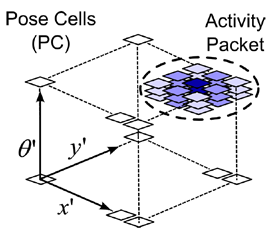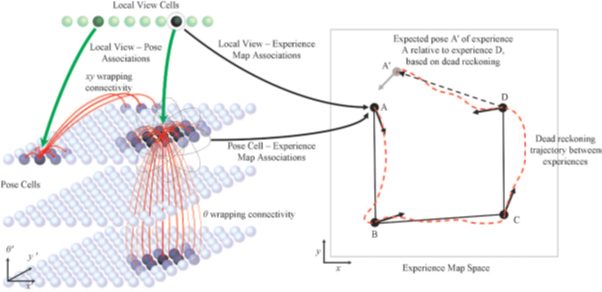
How to represent robot’s pose with a rate-coded neural network CAN in RatSLAM?
The excerpt note is about robot’s pose representation with a rate-coded neural network, continuous attractor network (CAN) in RatSLAM from Michael and Gordon 2010.
The CAN is a neural network that consists of an array of units with fixed weighted connections that can be both excitatory and inhibitory. Unlike most neural network, the CAN predominantly operates by varying the activity of the neural units, rather than by changing the value of the weighted connections.
RatSLAM uses a rate-coded CAN, meaning that each neural unit has a continuous activation value between zero and one. The interpretation of the unit activation level is generally as a measure of a real biological cell’s firing rate; the higher the activation level, the faster the firing rate it represents.
In rodents, spatially responsive cells such as place cells fire fastest when the rat is located at a certain location, and reduce their firing rates as the rat moves away from this location. In RatSLAM, the activation value of a neural unit increases when the robot approaches a location associated with that neural unit.
During operation, the pose cell network will generally have a single cluster of highly active units: the activity packet. The center of the activity packet provides an estimate of the robot’s pose that can be determined from the pose cell network’s structure.

The pose cell network is arranged in a rectangular prism structure. Any three-dimensional structure can be used, but optimal configurations are those where the structure tessellates in all three dimensions, which simplifies the connectivity required across network boundaries. Each of the three dimensions of the network corresponds to one of the three spatial dimensions  ,
, and
and  . Primed coordinates are used to differentiate the space from that used with the experience map. The location of the active neural units in the rectangular prism structure correlates with the robot’s pose in
. Primed coordinates are used to differentiate the space from that used with the experience map. The location of the active neural units in the rectangular prism structure correlates with the robot’s pose in  .
.

The RatSLAM system. The left part is Pose Cells Network
Michael Milford, and Gordon Wyeth. “Persistent Navigation and Mapping using a Biologically inspired SLAM System.” The International Journal of Robotics Research 29, no. 9 (2010): 1131-1153.
About
CogNav Blog
New discovery worth spreading on cognitive navigation in neurorobotics and neuroscience
Recent Posts
- How to build a bio-inspired hardware implementation of an analog spike-based hippocampus memory model?
- How does the brain select what to remember during sleep?
- How hippocampal activity encodes numerous memories of specific events in life?
- How egocentric coding properties arise from its presynaptic inputs, and how egocentric cells represent items across different behavioral contexts?
- How the medial entorhinal cortex develops during learning and influences memory?
Tags
Categories
- 3D Movement
- 3D Navigation
- 3D Path Integration
- 3D Perception
- 3D SLAM
- 3D Spatial Representation
- AI Navigation
- Bio-Inspired Robotics
- Brain-Inspired Navigation
- Cognitive Map
- Cognitive Navigation
- Episodic Memory
- Excerpt Notes
- Flying Vehicle Navigation
- Goal Representation
- Insect Navigation
- Learning to Navigate
- Neural Basis of Navigation
- Path Integration
- Path Planning
- Project
- Research Tips
- Robotic Vision
- Self-Flying Vehicles
- Spatial Cognition
- Spatial Cognitive Computing
- Spatial Coordinate System
- Spatial Memory
- Time
- Unclassified
- Visual Cortex
- Visual Cue Cells
Links
- Laboratory of Nachum Ulanovsky
- Jeffery Lab
- BatLab
- The NeuroBat Lab
- Taube Lab
- Laurens Group
- Romani Lab
- Moser Group
- O’Keefe Group
- DoellerLab
- MilfordRobotics Group
- The Space and Memory group
- Angelaki Lab
- Spatial Cognition Lab
- McNaughton Lab
- Conradt Group
- The Fiete Lab
- The Cacucci Lab
- The Burak Lab
- Knierim Lab
- Clark Spatial Navigation & Memory Lab
- Computational Memory Lab
- The Dombeck Lab
- Zugaro Lab
- Insect Robotics Group
- The Nagel Lab
- Basu Lab
- Spatial Perception and Memory lab
- The Neuroecology lab
- The Nagel Lab
- Neural Modeling and Interface Lab
- Memory and Navigation Circuits Group
- Neural Circuits and Memory Lab
- The lab of Arseny Finkelstein
- The Epstein Lab
- Gu Lab (Spatial Navigation and Memory)
- Fisher Lab (Neural Circuits for Navigation)
- The Alexander Lab (Spatial Cognition and Memory)
- Harvey Lab (Neural Circuits for Navigation)
- Buzsáki Lab
- ……
